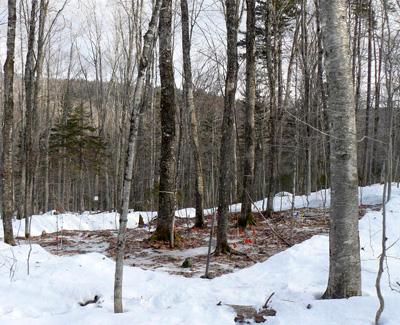Effects of Winter Climate Change on Growing Season Sap Flow and Carbon Exchange in the Northern Hardwood Forest

Scientists project winter warming in the northeastern United States of about 4 degrees Celsius by the end of the 21st century and a 12-30% increase in winter precipitation, with more falling as rain compared to what is currently observed. These changes in climate are expected to result in a reduced snowpack depth and duration. In the absence of an insulating layer of snow, soils can freeze when air temperatures drop below freezing.
NSRC researchers investigated how a reduced winter snowpack and increased frequency of soil frost might impact early growing season sap flow in northern hardwood trees. At Hubbard Brook Experimental Forest in New Hampshire and at Harvard Forest in Massachusetts, they shoveled snow from 13 x 13 meter plots for the first 4 to 6 weeks of winter to expose soils to below freezing air temperatures and to induce freeze/thaw cycles.
Measurements from snow-removal plots reveal that a greater depth and duration of soil freezing and increased frequency of freeze/thaw cycles lead to reduced rates of sap flow in red and sugar maple trees at the beginning of the growing season in mid-May to early June. But, there is no change in the more deeply rooted red oak trees. Findings provide new insight into the relationship between winter climate change and movement of water and sap in northern hardwood forests and demonstrate that not all tree species will respond similarly to winter climate change. If red oak and other deeply rooted species are more resilient to soil freeze/thaw events, these species could possibly out-compete co-occurring, shallow-rooted species.
Download printable version (PDF)
Download full final report (PDF)
